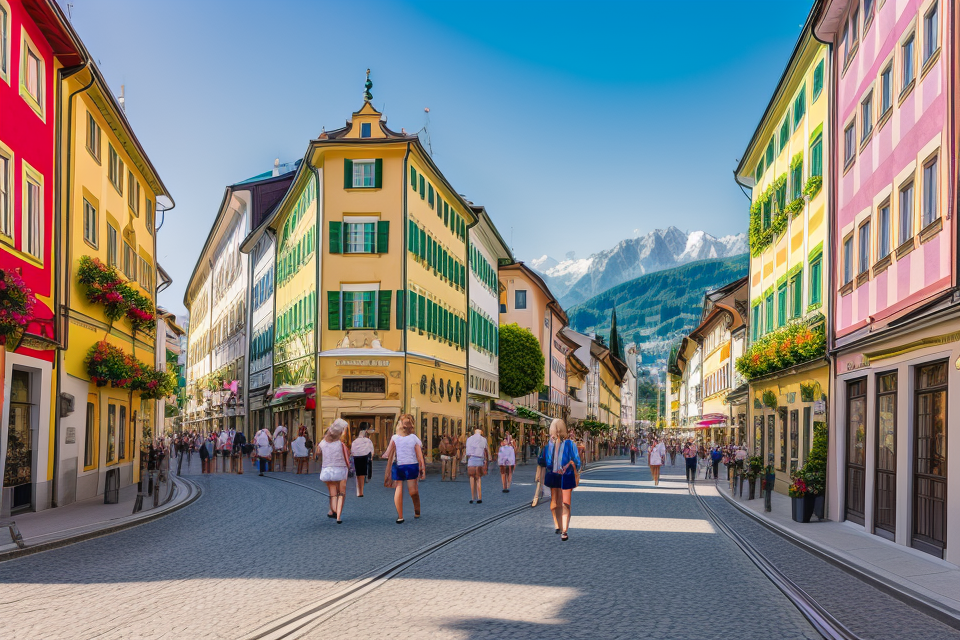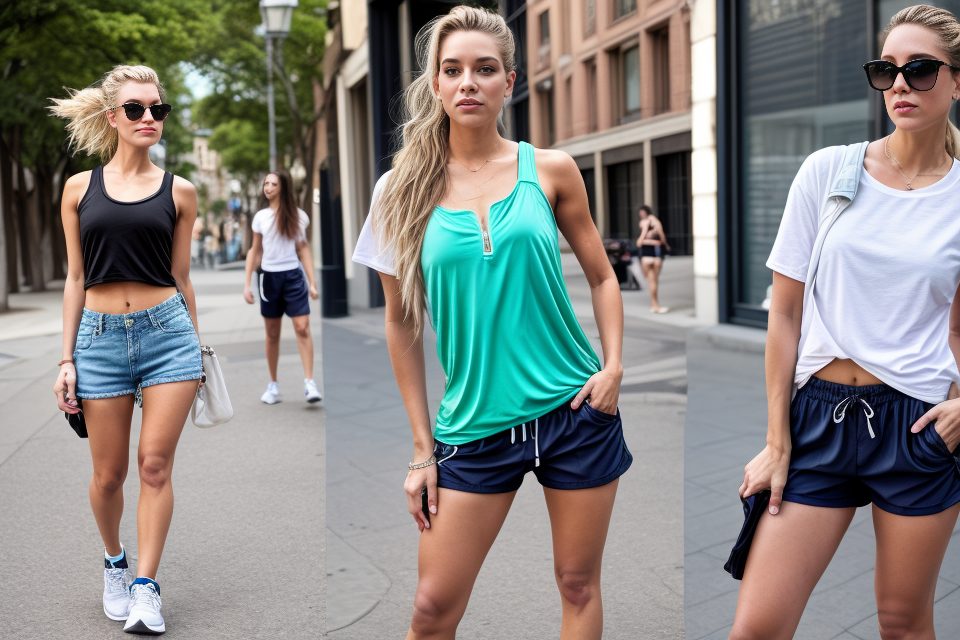Austria is a beautiful country with a rich culture and history, but when it comes to dress code, one might wonder if shorts are appropriate. In this comprehensive guide, we will explore the rules and regulations around wearing shorts in Austria, and provide tips on how to dress appropriately in different situations. From hiking in the Alps to strolling through the city streets, we’ll cover it all. So, if you’re planning a trip to Austria and wondering if you can wear shorts, read on to find out!
Yes, you can wear shorts in Austria, but it’s important to consider the context and cultural norms of the location you’re visiting. While shorts are generally acceptable in cities and tourist areas, they may not be appropriate in more conservative or traditional settings. Additionally, it’s always a good idea to dress respectfully when visiting religious sites or other places of significance. It’s also worth noting that the weather in Austria can be unpredictable, so it’s a good idea to pack a range of clothing options, including long pants and a light jacket, to be prepared for any weather conditions.
Is It Appropriate to Wear Shorts in Austria?
Cultural Norms and Attitudes towards Shorts
In Austria, the appropriateness of wearing shorts depends on several factors, including cultural norms and attitudes. While shorts are a common and practical garment in many parts of the world, they may not be as widely accepted in Austria, particularly in more formal settings.
Cultural norms and attitudes towards shorts in Austria are shaped by the country’s history, traditions, and social customs. For instance, Austrians tend to value formality and tradition, and this may influence their views on appropriate attire. In more conservative circles, shorts may be viewed as casual and inappropriate for certain settings, such as in business or professional environments.
Furthermore, Austria’s geography and climate also play a role in shaping attitudes towards shorts. As a Central European country, Austria experiences four distinct seasons, with winters that can be quite cold. As a result, shorts may not be seen as practical or appropriate clothing for cold or rainy weather.
However, it’s worth noting that attitudes towards shorts can vary significantly depending on the region and context. In tourist-friendly areas or larger cities, shorts may be more widely accepted and even embraced as a comfortable and stylish choice. Additionally, younger generations in Austria may be more open to wearing shorts in a variety of settings.
In conclusion, while cultural norms and attitudes towards shorts in Austria may differ from those in other countries, it’s important to be mindful of the context and the specific situation when deciding whether to wear shorts.
Weather and Seasonal Appropriateness
In Austria, the appropriateness of wearing shorts depends on the weather and the season. While it may be suitable to wear shorts during the summer months, it is not recommended to do so in other seasons.
During the summer, temperatures in Austria can reach up to 30°C (86°F) or higher, making it appropriate to wear shorts. This is especially true for popular tourist destinations such as Vienna, Salzburg, and Innsbruck, where the weather is typically warmer than in other parts of the country.
However, during the spring and autumn months, the weather in Austria can be unpredictable, with temperatures ranging from 10°C to 20°C (50°F to 68°F). While it may be cooler during these seasons, it is still possible to wear shorts, especially if you are in a warmer part of the country.
On the other hand, during the winter months, temperatures in Austria can drop below freezing, with snowfall common in many parts of the country. It is not appropriate to wear shorts during this time, as it can be considered inappropriate and could lead to discomfort due to the cold weather.
Therefore, it is essential to consider the weather and the season when deciding whether or not to wear shorts in Austria. While it may be appropriate during the summer months, it is not recommended to wear shorts during other seasons, especially in colder parts of the country.
What Type of Shorts Are Appropriate in Austria?
Length and Style Guidelines
When it comes to shorts in Austria, it’s important to consider both the length and style of the garment. In general, shorts should fall at or above the knee, and it’s best to avoid wearing anything too revealing or casual.
Here are some specific guidelines to keep in mind:
- Length: As mentioned, shorts should be at or above the knee. It’s important to note that this applies to both men and women.
- Fabric: Shorts can be made from a variety of fabrics, including denim, cotton, and synthetic materials. However, it’s generally best to avoid wearing shorts made from synthetic materials, as they can be see-through and inappropriate for certain settings.
- Style: Shorts should be neat and well-maintained, with no tears or stains. Avoid wearing anything too casual, such as athletic shorts or denim shorts with rips and holes. Instead, opt for dressier options like khaki shorts or shorts made from high-quality materials like linen or silk.
It’s also worth noting that shorts should never be worn to very formal events or settings, such as weddings or formal dinners. In these cases, it’s best to opt for a dress or skirt instead.
Fabric and Comfort Considerations
When choosing shorts to wear in Austria, it’s important to consider both the fabric and the level of comfort they provide.
Materials to Avoid
Some materials are not suitable for wearing in Austria due to their inability to wick moisture away from the skin or their tendency to become transparent when wet. For example, synthetic materials like polyester and nylon are not ideal for outdoor activities in Austria due to their poor moisture-wicking properties. Similarly, cotton, while comfortable, is not a good choice for outdoor activities as it is not quick-drying and can become heavy when wet.
Materials to Consider
On the other hand, there are several fabrics that are ideal for wearing in Austria. For example, moisture-wicking materials like merino wool, bamboo, and Tencel are excellent choices for shorts in Austria. These materials are breathable, comfortable, and can help regulate body temperature, making them perfect for outdoor activities in any season. Additionally, they are quick-drying, which means they can be easily washed and dried.
Comfort Considerations
When choosing shorts to wear in Austria, it’s also important to consider comfort. While some people may prefer loose-fitting shorts, others may prefer a snugger fit for more support during physical activities. It’s also important to consider the length of the shorts, as some may be more appropriate for certain activities than others. For example, longer shorts may be more suitable for hiking or cycling, while shorter shorts may be more appropriate for casual wear or beach activities.
Overall, when choosing shorts to wear in Austria, it’s important to consider both the fabric and the level of comfort they provide. Moisture-wicking materials like merino wool, bamboo, and Tencel are excellent choices, as are shorts that fit comfortably and provide the necessary support for the activity at hand.
Where Can You Wear Shorts in Austria?
Touristy Areas and Landmarks
While the traditional Austrian dress code may be conservative, the country’s touristy areas and landmarks tend to be more relaxed in their attire requirements. Here are some of the places where you can comfortably wear shorts in Austria:
Vienna
As the capital city of Austria, Vienna is a popular tourist destination and a hub for cultural events. While the dress code in some of the more formal establishments may still require trousers or skirts, shorts are generally acceptable in most public areas, such as parks, cafes, and shopping districts. However, it’s always a good idea to exercise discretion and respect the dress code of specific establishments or events.
Salzburg
Salzburg, the birthplace of Mozart, is a picturesque city known for its baroque architecture and stunning scenery. As a popular tourist destination, the city has a more relaxed dress code, and shorts are generally acceptable in most public areas, including the historic city center and the Salzburg Fortress. However, it’s important to note that some religious or formal establishments may still require modest attire.
Innsbruck
Innsbruck, located in the Tyrol region of Austria, is a popular destination for winter sports enthusiasts. While the city has a strong tradition of formal attire, the touristy areas and landmarks, such as the Golden Roof and the Nordkette Mountains, are more relaxed in their dress code. Shorts are generally acceptable in these areas, but it’s always a good idea to be respectful of the local customs and traditions.
Lake Constance
Lake Constance, located on the border of Austria, Germany, and Switzerland, is a popular destination for outdoor activities and scenic views. As a popular tourist area, the dress code is generally more relaxed, and shorts are acceptable in most public areas, including the lakeside promenade and the surrounding hiking trails. However, it’s important to note that some formal establishments, such as restaurants and hotels, may still require appropriate attire.
Overall, while Austria may have a conservative dress code, the country’s touristy areas and landmarks tend to be more relaxed and accepting of shorts as a suitable form of attire. However, it’s always a good idea to exercise discretion and respect the local customs and traditions, especially in more formal or religious establishments.
Everyday Life and Local Customs
In everyday life, shorts are generally considered appropriate attire for warm weather in Austria. However, it’s important to keep in mind that Austrian culture values modesty and respect for traditional customs.
In more conservative areas or during formal events, it may be best to err on the side of caution and wear longer pants. Additionally, when visiting churches or other religious sites, it’s recommended to dress conservatively and cover your knees.
When dining out, it’s common to see locals wearing casual clothing, but it’s always a good idea to check the dress code of the restaurant beforehand. In general, smart casual attire is usually acceptable.
Overall, it’s important to be mindful of the local customs and dress appropriately for the occasion to avoid any unwanted attention or offense.
What to Wear with Shorts in Austria?
Shoes and Accessories
When it comes to pairing shoes and accessories with shorts in Austria, there are a few key things to keep in mind. Firstly, it’s important to dress appropriately for the occasion. If you’re attending a formal event or dinner, you may want to opt for dressier shoes and accessories that complement your outfit. On the other hand, if you’re going for a more casual look, you can choose more relaxed footwear and accessories that complement your shorts.
Here are some suggestions for shoes and accessories to wear with shorts in Austria:
- Sneakers: Sneakers are a great option for a casual look with shorts. They’re comfortable, versatile, and can be dressed up or down depending on the occasion. If you’re going for a more dressed-up look, you can opt for sneakers with a sleek design or in a neutral color like black or white.
- Loafers: Loafers are another great option for a more formal look with shorts. They’re comfortable and versatile, and can be dressed up or down depending on the occasion. If you’re going for a more dressed-up look, you can opt for loafers in a neutral color like black or brown.
- Sandals: Sandals are a great option for a more casual look with shorts. They’re comfortable, versatile, and can be dressed up or down depending on the occasion. If you’re going for a more dressed-up look, you can opt for sandals with a sleek design or in a neutral color like black or brown.
- Watch: A watch is a great accessory to wear with shorts in Austria. It adds a touch of sophistication to your outfit and can be dressed up or down depending on the occasion. If you’re going for a more dressed-up look, you can opt for a watch with a sleek design or in a neutral color like silver or gold.
- Belt: A belt is another great accessory to wear with shorts in Austria. It adds a touch of sophistication to your outfit and can be dressed up or down depending on the occasion. If you’re going for a more dressed-up look, you can opt for a belt in a neutral color like black or brown.
Remember, the key is to dress appropriately for the occasion and to choose shoes and accessories that complement your outfit. With these tips in mind, you’ll be sure to look stylish and put-together no matter where you go in Austria.
Layering and Mix-and-Match Options
When planning your outfit in Austria, layering is key to creating a stylish and functional look. Layering allows you to add or remove clothing as needed, depending on the weather and your personal comfort level. With shorts, there are a variety of layering and mix-and-match options to consider, depending on the occasion and the season.
T-shirts and Long-sleeved Shirts
T-shirts and long-sleeved shirts are classic options for layering with shorts. For a casual look, pair a short-sleeved T-shirt with a pair of denim shorts and sneakers. For a more formal look, opt for a long-sleeved shirt tucked into a pair of tailored shorts, paired with loafers or dress shoes.
Lightweight Sweaters and Cardigans
In cooler weather, layering a lightweight sweater or cardigan over your shorts is a great way to stay warm without sacrificing style. A thin knit sweater can be worn with any type of shorts, from denim to chinos, and can be easily removed when the weather warms up.
Vests and Waistcoats
Vests and waistcoats are another layering option that can add a touch of sophistication to your outfit. A short-sleeved vest can be worn over a T-shirt and shorts for a more formal look, while a long-sleeved waistcoat can be paired with a button-down shirt and dress shorts for a stylish and professional ensemble.
Blazers and Jackets
Blazers and jackets are essential layering pieces for any wardrobe, and they can be easily incorporated into a shorts-based outfit. A lightweight blazer can be worn over a T-shirt and shorts for a polished look, while a denim jacket can add a casual and relaxed vibe to your outfit.
Overall, layering and mix-and-match options are key to creating a versatile and stylish wardrobe when visiting Austria. Whether you prefer a casual or formal look, there are plenty of layering options to choose from that will allow you to enjoy the beauty of the country while staying comfortable and confident in your clothing choices.
How to Dress Respectfully When Wearing Shorts in Austria?
Modesty and Decency
While Austria is generally a liberal and open-minded country, it is important to remember that modesty and decency are still valued. Here are some guidelines to follow when wearing shorts in Austria:
- Knee-length or longer: It is recommended to wear shorts that are knee-length or longer to ensure that you are covered and modest. This is especially important when visiting more traditional or conservative areas of the country.
- Avoid showing too much skin: While shorts are acceptable in many situations, it is important to avoid showing too much skin. Avoid wearing shorts that are tight, revealing, or have a low rise. Opt for looser, more comfortable styles that still cover your legs.
- Consider the occasion: Keep in mind that Austria is a formal country, and it is important to dress appropriately for different occasions. If you are attending a formal event or visiting a place of worship, it is best to err on the side of caution and wear longer shorts or pants.
- Be mindful of the weather: While it can get hot in Austria, especially during the summer months, it is important to be mindful of the weather when choosing what to wear. If it is scorching hot, it may be acceptable to wear shorter shorts, but if it is cooler or rainy, it is best to opt for longer shorts or pants to stay warm and dry.
By following these guidelines, you can ensure that you are dressing respectfully and modestly when wearing shorts in Austria.
Mindfulness of Austrian Etiquette
When visiting Austria, it’s important to be mindful of the local customs and etiquette, especially when it comes to dressing appropriately. While shorts may be a common and comfortable choice of attire for many visitors, it’s important to consider the context and potential impact of wearing them in different settings. Here are some key points to keep in mind:
- Respect for Religious and Cultural Sites: In many religious and cultural sites in Austria, such as churches and museums, it’s important to dress modestly and cover your shoulders and knees. Shorts that are too short or revealing may not be appropriate in these settings, so it’s a good idea to check the dress code before visiting.
- Professional Settings: In more formal or professional settings, such as business meetings or job interviews, it’s generally best to err on the side of caution and wear more conservative clothing, including full-length pants or skirts. Shorts may not be considered appropriate in these contexts.
- Outdoor Activities: When engaging in outdoor activities, such as hiking or cycling, it’s important to consider the practicality and functionality of your clothing choices. While shorts may be comfortable and suitable for these activities, it’s also important to consider the potential weather conditions and terrain, and bring appropriate clothing layers and gear.
- City Tourism: In many cities in Austria, such as Vienna and Salzburg, it’s important to dress respectfully and avoid wearing revealing or casual clothing in more public or formal areas, such as city centers or public transportation. It’s a good idea to blend in with the local style and dress in more classic, timeless clothing choices.
By being mindful of these key points and showing respect for Austrian customs and etiquette, you can ensure a more enjoyable and respectful visit to this beautiful country.
Tips for Enjoying Your Visit to Austria in Shorts
While shorts are a popular choice of attire for many, it’s important to be mindful of cultural norms and practices when traveling. Here are some tips to help you enjoy your visit to Austria while wearing shorts:
- Be aware of the occasion: It’s always a good idea to dress appropriately for the occasion. For instance, you may want to avoid wearing shorts to formal events such as weddings or formal dinners.
- Dress appropriately for the weather: While shorts may be comfortable in warm weather, it’s important to check the weather forecast before heading out. You may want to bring a light jacket or sweater to wear in case of cooler temperatures or sudden changes in weather.
- Consider the activity: If you’re planning on participating in outdoor activities such as hiking or cycling, it’s a good idea to wear shorts that are comfortable and functional. However, if you’re planning on visiting a museum or other indoor attractions, you may want to opt for longer pants or skirts.
- Respect local customs: While shorts are generally acceptable in Austria, it’s important to be respectful of local customs and traditions. For instance, you may want to avoid wearing shorts in more conservative areas or during religious events.
- Pack appropriately: When packing for your trip, be sure to bring a variety of clothing options that can be mixed and matched to create different outfits. This way, you can easily adapt to different weather conditions and activities without having to pack additional clothing.
By following these tips, you can enjoy your visit to Austria while wearing shorts with confidence and respect for local customs.
FAQs
1. Is it appropriate to wear shorts in Austria?
Wearing shorts in Austria is generally considered acceptable, especially during the summer months. However, it’s important to note that Austria is a conservative country, and some places, such as churches and formal settings, may require more modest attire.
2. What type of shorts are suitable for wearing in Austria?
In general, shorts that are knee-length or longer are considered appropriate for most settings in Austria. Avoid wearing very short shorts or those that are revealing, as these may be considered inappropriate or offensive.
3. Are there any specific occasions when shorts are not appropriate in Austria?
Yes, there are certain occasions when shorts may not be appropriate in Austria. For example, when visiting churches or other religious sites, it’s best to wear clothing that covers your knees and shoulders as a sign of respect. In formal settings, such as business meetings or formal dinners, it’s best to avoid wearing shorts altogether and opt for more formal attire.
4. Can I wear shorts while hiking or engaging in outdoor activities in Austria?
Yes, shorts are a popular choice for hiking and other outdoor activities in Austria. However, it’s important to pack a pair of longer shorts or pants for times when you may need to cover up, such as when visiting churches or other religious sites.
5. What are some tips for wearing shorts in Austria?
When wearing shorts in Austria, it’s important to consider the occasion and dress appropriately. Avoid wearing very short shorts or those that are revealing, and always cover your knees and shoulders when visiting religious sites. Additionally, be mindful of the weather and pack accordingly, as temperatures can vary significantly throughout the day.



